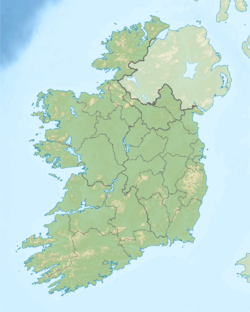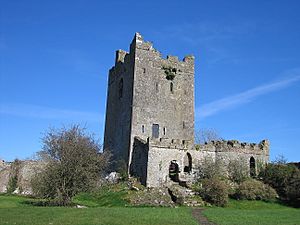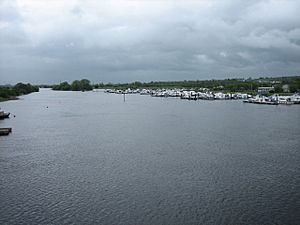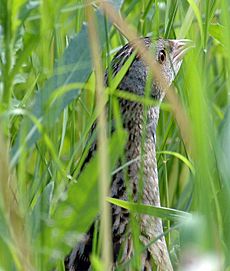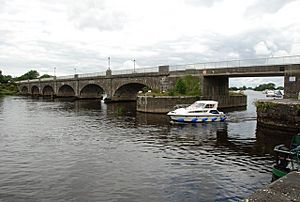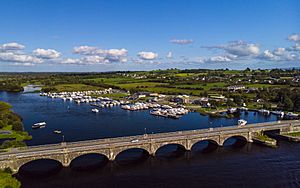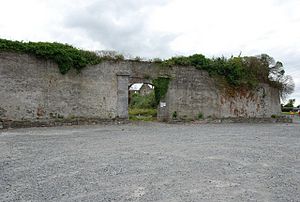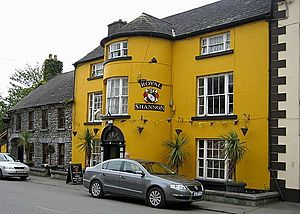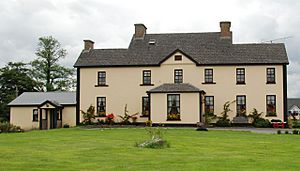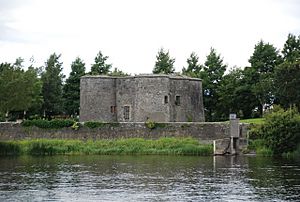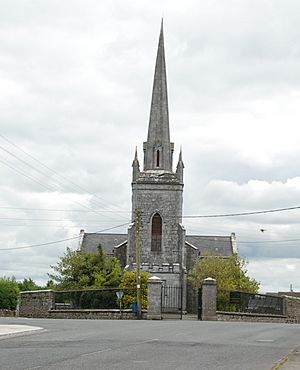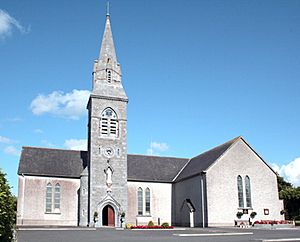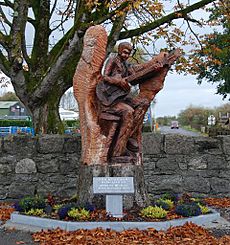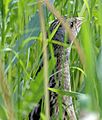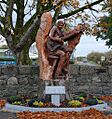Banagher facts for kids
Quick facts for kids
Banagher
Beannchar na Sionna
|
|
|---|---|
|
Town
|
|
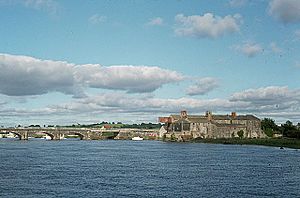
Banagher Bridge and Maltings
|
|
| Country | Ireland |
| Province | Leinster |
| County | Offaly |
| Area | |
| • Total | 1.80 km2 (0.69 sq mi) |
| Elevation | 47 m (154 ft) |
| Population
(2022)
|
1,907 |
| Time zone | UTC+0 (WET) |
| • Summer (DST) | UTC-1 (IST (WEST)) |
| Historical population | ||
|---|---|---|
| Year | Pop. | ±% |
| 1821 | 2,813 | — |
| 1831 | 2,636 | −6.3% |
| 1841 | 2,827 | +7.2% |
| 1851 | 1,846 | −34.7% |
| 1861 | 1,426 | −22.8% |
| 1871 | 1,206 | −15.4% |
| 1881 | 1,192 | −1.2% |
| 1891 | 1,164 | −2.3% |
| 1901 | 1,114 | −4.3% |
| 1911 | 891 | −20.0% |
| 1926 | 788 | −11.6% |
| 1936 | 720 | −8.6% |
| 1946 | 636 | −11.7% |
| 1951 | 840 | +32.1% |
| 1956 | 1,027 | +22.3% |
| 1961 | 1,050 | +2.2% |
| 1966 | 1,154 | +9.9% |
| 1971 | 1,052 | −8.8% |
| 1981 | 1,378 | +31.0% |
| 1986 | 1,465 | +6.3% |
| 1991 | 1,423 | −2.9% |
| 1996 | 1,414 | −0.6% |
| 2002 | 1,553 | +9.8% |
| 2006 | 1,636 | +5.3% |
| 2011 | 1,653 | +1.0% |
| 2016 | 1,760 | +6.5% |
| 2022 | 1,907 | +8.4% |
Banagher is a charming town in Ireland, located in the middle of the country. It sits on the western edge of County Offaly, right by the River Shannon. In the mid-1800s, Banagher was a busy place with about 3,000 people. Today, its population is around 1,907, based on the 2022 census.
Banagher has always been an important spot because it's one of the few places to cross the River Shannon. This river acts like a natural border between the provinces of Leinster and Connacht. Because of its key location, many historic buildings were built here. You can find a 19th-century Martello Tower and several castles from the 14th and 15th centuries. The town was once a hub for river trade, connecting Dublin and Limerick. While old industries like malt production and distilleries are gone, tourism is now important. There's a modern marina for river boats and watersports. Banagher is also a great place for fishing, especially for pike. The town is surrounded by the Shannon Callows, which are grassy meadows that flood in winter. These areas are a special home for many kinds of waterfowl.
Contents
- What Does Banagher Mean?
- A Look at Banagher's Past
- Banagher's Geography
- Banagher's Economy
- Getting Around Banagher
- How Banagher is Governed
- Banagher's Culture
- Education in Banagher
- Sports in Banagher
- Notable People from Banagher
- Images for kids
- See also
What Does Banagher Mean?
The name Banagher comes from the Irish word 'Beannchar'. Many Irish place names describe natural features, and 'Beannchar' is one of them. 'Beann' means 'peak' or 'top', often used for hills and mountains. 'Cor' means a rounded or curved hill. So, Banagher might mean "the place of the pointed rocks on the Shannon."
A Look at Banagher's Past
It's believed that St. Rynagh, who founded Banagher, was the sister of St. Finnian of Clonard. She came from County Wexford and founded a religious community in Banagher. St. Rynagh's mother, Talech, even became the leader (Abbess) of the Banagher convent. St. Rynagh is thought to have died around 610 AD.
How Banagher Started
Banagher began as a settlement near a shallow crossing point on the east bank of the River Shannon. This area was always dry, even when the river flooded. Travelers used this spot to cross the Shannon, and soon a community grew there.
Many early travelers were pilgrims visiting nearby monasteries. North-west of Banagher, on the Connacht side, was Clonfert, and further north was the famous Clonmacnoise. To the south-west was another monastery at Meelick. Banagher's location was important because it was where three provinces (Leinster, Munster, and Connacht) and four church areas (dioceses) met.
Banagher's Military History
Banagher was very important for military reasons because the Shannon River created a natural barrier between Connacht and Leinster. Armies crossing the river had few options, and Banagher was one of them. The first bridge here was built as early as 1049.
The English realized Banagher's importance and took control of it in the mid-1500s. They built forts like Fort Frankford (later Fort Falkland) to protect the area. Even though the local MacCoghlan clan controlled much of Offaly, the English held Banagher. Castles like Garry Castle, Clonony Castle, and Moystown Castle were strongholds of the MacCoghlan family. In 1621, King James I ordered the MacCoghlan lands to be taken over.
In 1628, King Charles I officially made Banagher a town. This allowed the town to elect two members to Parliament and hold two fairs each year. A permanent military base was set up in 1628, which stayed until 1863.
During the Williamite Wars (1690–1691), Banagher supported King James II. A stone bridge was built in 1685. In 1690, an army supporting William tried to destroy it but couldn't because Sarsfield's army was on the other side. A broken arch of this old bridge can still be seen today. The current bridge, with seven arches, was built between 1841 and 1843. The square tower and Salt Battery near the bridge were built to protect it. The English army stayed in Banagher until the mid-1800s.
How Banagher Grew and Declined
In the 1600s, Banagher was known for its wool trade. However, taxes on wool exports to England in 1699 hurt this business. Later, a ban on food exports during the American Revolutionary War also affected Banagher. But in 1780, these restrictions were lifted, and Banagher's economy started to boom.
From 1800 to 1847, Banagher was very successful. Growing corn was a main activity, and the opening of the Grand Canal in the late 1700s made it easy to transport goods to Dublin and Limerick. Banagher became a major center for grain, and its Friday corn market was one of the biggest in Ireland. New industries like a distillery, brewery, tanneries, and corn mills opened. The town's population grew from 1,500 in 1800 to 3,000 in 1846.
However, the second half of the 1800s saw a rapid decline. The population dropped by over 57% between 1841 and 1881. The end of the Corn Laws in 1846 meant cheaper grain could be imported, hurting Irish farmers. Smaller local industries couldn't compete with larger British ones. The Great Irish Famine also had a huge impact.
The opening of Banagher Railway station in 1884 brought some improvement, with trains connecting the town to Clara. But passenger services stopped in 1947, and the line closed completely in 1963. Today, the marina covers the old station site, but you can still see where the tracks used to be.
Banagher's Geography
Banagher is in north-west County Offaly, on the east bank of the River Shannon. It's about 106 km (66 mi) south-west of Dublin. The town is built on high ground, so it usually stays dry even though it's in the flood-plain of the River Shannon. North of Lough Derg, the Shannon flows very slowly and often floods the surrounding countryside. This creates the Shannon Callows, a wet grassland area that is a special home for wild birds and wildlife.
The area around Banagher is often described as being like the Fens in England, with many waterways. The Shannon itself, its smaller rivers like the Suck, Brosna, and Little Brosna, and the Grand Canal all flow through here.
A writer named James Pope-Hennessy described the River Shannon at Banagher in September as "glorious." He noted the golden autumn mornings and how the river reflects the beautiful sunsets.
The Slieve Bloom Mountains are to the south of Banagher, and the town is surrounded by large bogs (wetlands), especially to the east and west. The River Brosna joins the Shannon about three kilometers north of Banagher.
Weather in Banagher
Banagher has a mild climate. In July, the average high temperature is 18 °C (64 °F), and in January, it's 8 °C (46 °F). The town gets about 804 mm (31.7 in) of rain each year, which is less than the west coast of Ireland.
| Climate data for Banagher, Ireland. | |||||||||||||
|---|---|---|---|---|---|---|---|---|---|---|---|---|---|
| Month | Jan | Feb | Mar | Apr | May | Jun | Jul | Aug | Sep | Oct | Nov | Dec | Year |
| Record high °C (°F) | 14 (57) |
15 (59) |
20 (68) |
24 (75) |
26 (79) |
31 (88) |
31 (88) |
30 (86) |
25 (77) |
22 (72) |
18 (64) |
15 (59) |
31 (88) |
| Mean daily maximum °C (°F) | 8 (46) |
8 (46) |
10 (50) |
12 (54) |
15 (59) |
18 (64) |
18 (64) |
19 (66) |
17 (63) |
14 (57) |
10 (50) |
8 (46) |
13 (55) |
| Mean daily minimum °C (°F) | 2 (36) |
2 (36) |
3 (37) |
4 (39) |
6 (43) |
9 (48) |
11 (52) |
10 (50) |
9 (48) |
7 (45) |
3 (37) |
3 (37) |
6 (43) |
| Record low °C (°F) | −15 (5) |
−15 (5) |
−11 (12) |
−5 (23) |
−2 (28) |
0 (32) |
3 (37) |
1 (34) |
−1 (30) |
−3 (27) |
−7 (19) |
−9 (16) |
−15 (5) |
| Average precipitation mm (inches) | 76 (3.0) |
54 (2.1) |
61 (2.4) |
53 (2.1) |
68 (2.7) |
55 (2.2) |
59 (2.3) |
78 (3.1) |
71 (2.8) |
84 (3.3) |
74 (2.9) |
79 (3.1) |
804 (31.7) |
Amazing Wildlife
In autumn and winter, the Shannon Callows are home to many waders (birds that wade in water), swans, and other wildfowl. You'll often see mute swans, Eurasian coots, common moorhens, and little grebes. Kingfishers are common, as are meadow pipits and pied wagtails. This area has one of the largest groups of breeding waders in Ireland, including lapwings, redshanks, common sandpipers, and black-tailed godwits.
The corncrake, a globally threatened bird, can be seen near Banagher bridge in summer. These birds are rare, but the hay meadows of the callows are one of the few places where they are still common.
In winter, more birds arrive from north-east Europe, like the Eurasian wigeon and the Greenland white-fronted goose. You might also spot riverside mammals like Eurasian otters, American minks, and red foxes. While trout and salmon are less common now, pike are still plentiful, attracting many anglers.
People of Banagher
Banagher's history as a "plantation" town (where English settlers were given land) means it has both Catholic and Church of Ireland communities. These communities still have active churches today.
In the late 1900s, people from Germany, the Netherlands, and Switzerland moved to Banagher, drawn by the River Shannon. Some still live there. More recently, people from Eastern Europe, like Poland, have moved to the area, making up about 4% of the population.
In 2011, Banagher had 1,653 residents. By 2022, the population grew to 1,907 people.
Banagher's Economy
After the canal and malt businesses declined, Banagher faced tough times. However, some companies helped keep people employed. Bord na Móna, a company that harvested peat from Ireland's bogs, was a big employer. But with new machines and bogs running out, it's not as big an employer anymore.
Green Isle Foods used to have a facility near Banagher, providing many jobs in the 1970s and 80s. Now, it's only used for storage. The largest industry in Banagher today is Banagher Precast Concrete Limited. This company makes precast concrete structures and employs about 150 people. They've supplied parts for famous projects like the Aviva Stadium, Croke Park, the Channel Tunnel, and the Dublin Port Tunnel. Other important businesses include Banagher Sawmills and companies that rent out cruise boats at the marina.
Getting Around Banagher
Banagher is an important crossing point on the River Shannon, so it has a lot of traffic. Two regional roads meet here: the R356 (Harbour Street) and the R439 (Main Street).
A railway station opened in Banagher in 1884, connecting it to Clara. It carried both passengers and goods. Passenger service stopped in 1947, and the station closed completely in 1963.
Banagher was once a hub for river transportation on the Shannon. While river transport declined with the rise of roads and railways, Banagher is still a popular spot for river cruisers. Several companies operate from the town's marina.
How Banagher is Governed
Banagher is part of the local council area of Offaly County Council. This council handles things like planning, local roads, sanitation, and libraries. The council has 21 elected members, and Banagher is in the Birr electoral area, which elects five members.
The town is in the Barony of Garrycastle. Its eastern part is in the townland of Curraghavarna and Portavrolla, and its western part is in the townland of Banagher or Kylebeg.
Banagher's Culture
The Famous Banagher Fair
As early as 1612, Banagher had a fair. When the town was officially recognized in 1628, it was given permission to hold two more fairs each year. These fairs grew very large and important. In 1826, an amazing 43,000 sheep were offered for sale at the September fair!
The September fair was the main one and is still held today. It was so big that the line of horses stretched from the Shannon river bridge for two and a half miles! By the early 1900s, the fair was famous internationally. In 1909, a newspaper reported that buyers from the Italian and Russian governments were there. Eighty-nine train wagons of horses were sent from Banagher Railway Station, totaling about 500 horses.
Buildings and Structures
Banagher Bridge
The first known bridge here was a "spacious stone bridge of 18 arches" built around 1049 by Ruaidrí Ua Conchobair, the King of Connacht. Later, medieval records mention a "bridge of 27 arches" that stood for over 500 years. A stone bridge with 17 arches was built in 1685.
This 1685 bridge was important during the Williamite War. Patrick Sarsfield used it to retreat after an ambush. Because of this, it was sometimes called Sarsfield's Bridge. This bridge was blown up in 1843. You can still see a part of it next to Cromwell's Castle.
The current bridge, with seven arches, was built between 1841 and 1843. It was designed by Thomas Rhodes. In 1971, the bridge was rebuilt and widened. The old stone walls were replaced with aluminum railings, and a swivel arch (which let tall boats pass) was removed.
Experts say Banagher Bridge is very important for its history and architecture. It's the only six-arch stone bridge in the county and has the longest stone arches of all the bridges in Offaly. All the castles and forts around the bridge, like Cromwell's Castle and the Martello Tower, were built to protect it. They could also destroy the bridge if needed.
A narrow path goes under the old swivel part of the bridge. This path has a handrail known as the Duke's Rail. In 1897, the Duke of York (who later became King George V) visited Ireland. He used this rail to get from his steamship to the railway station. The part of the Shannon from Portumna to Banagher was even called the Duke of York's Route for a while.
Old Barracks
This building, once a police barracks, was built around 1800. Now in ruins, it has stone walls that are thought to be the outer walls of Fort Falkland from 1642. In 1824, it was said to house soldiers, officers, and had a bomb-proof magazine and artillery guns. It was also believed to have been a nunnery (perhaps St. Rynagh's) and connected to Saint Rynagh's Old Abbey by an underground passage. After the British army left in 1863, the barracks was used by the police. It was burned after the Anglo-Irish Treaty in 1921. Most of the inside was illegally torn down in the 1990s.
Georgian Houses
Banagher has two beautiful Georgian buildings from the 1700s. One is called Crank House, located at the corner of Main Street and Crank Road. It was restored in the 1990s and is now a community center with a tourist office and a hostel. It also houses the Midlands office of Birdwatch Ireland.
The second building is a three-story house that has been a hotel since the early 1800s. Anthony Trollope stayed here in the 1840s. It's near the marina and bridge. It was called the 'Shannon Hotel' and later 'The Royal Shannon'. It's no longer a hotel and is sadly falling apart.
Charlotte's Way
Charlotte's Way, once known as Hill House, is near St. Paul's Church of Ireland church. This house was home to Charlotte Brontë's husband, Mr. Nicholls, after Charlotte died. Nicholls lived there until his death in 1906. The house's connection to Charlotte Brontë and the Brontë family is why it has its current name. It's a two-story house built in 1753 and is now a bed and breakfast.
Cromwell's Castle
Cromwell's Castle, located on the Canal Bank, got its current look during the Napoleonic Wars. Like the Martello Tower across the river, it was rebuilt to defend against any invading ships coming up the Shannon.
The English had many forts on the Leinster side of the river. The fort at Banagher was taken by the Confederate Catholics in 1642 but recaptured by Cromwell's army in 1650. The Cromwellians built a new fort on the Connacht side. In 1817, the castle was changed to hold artillery, with a platform for a large gun on its roof. Its inside became a place to store gunpowder and housed 20 soldiers.
The Banagher Branch of the Offaly Historical Society has been working to restore the castle since the 1980s. The Canal Bank, where it stands, is a public park. The castle, park, and riverside walk are open to everyone.
Cuba Court
Cuba Court, also called Cuba House, was a grand house built in the 1730s. It might have been designed by Sir Edward Lovett Pearce, who designed the Irish Houses of Parliament in Dublin. It was built with money from sugar plantations in Cuba. Writer James Pope-Hennessy described it as "a fine example of an Irish country-house." It had two round rooms and a path of lime trees leading to the front door.
In the late 1700s, Cuba Court was home to Denis Bowes Daly. Later, it was leased to the Army Medical Board and then became the Royal School.
Charlotte Brontë spent her honeymoon at Cuba Court in 1854. She wrote that it was "very large" and looked like a "gentleman's country seat." She noted that some rooms were "lofty and spacious" and "handsomely and commodiously furnished."
Sir William Wilde, the father of Oscar Wilde, attended the Royal School at Cuba Court in the 1820s. Another student was William Bulfin, a journalist whose son, Eamon Bulfin, was involved in the 1916 Easter Rising in Dublin.
Sadly, Cuba Court was unroofed in 1946 due to a policy on rates, which led to its ruin. It was eventually demolished in the 1980s.
Fort Eliza
Fort Eliza, also known as the Salt Battery, is a five-sided fort built around 1812. It stands on the east side of the River Shannon. Three sides face the river, and it was surrounded by a dry moat. Inside was a brick-vaulted powder magazine. This fort, along with Cromwell's Castle, the Martello tower, and Fort Falkland, protected the town and the river crossing from all directions.
Martello Tower
Martello towers are small, round defensive forts built by the British Empire in the 1800s, especially during the Napoleonic Wars. They are about 12 meters (40 ft) high and have thick stone walls that could resist cannon fire. Their flat roofs held a single heavy artillery gun that could turn 360 degrees.
Because people feared an invasion by Napoleon Bonaparte, two Martello towers were built on the River Shannon to defend its crossing points. One was at Meelick, and the other is in Banagher. The Banagher tower is on the west (Galway) bank of the river and is 11 meters (36 ft) in diameter and height.
Memorials and Sculptures
On the eastern side of town, there's a stone Celtic Cross called the Barnes & McCormack Memorial. It honors two local men who were executed in Birmingham in 1940. The cross was put up in 1963 and has an inscription in both Irish and English. It features images of the two men, a female head representing Ireland, and symbols of the four provinces.
In December 2011, a Zimbabwean artist named Parazai Havatitye created a wood sculpture from a tree stump called The Musician. It's dedicated to the musician Johnny McEvoy, who was born in Banagher in 1945. The sculpture is on the main road, near the marina gate.
Places to Worship
Because of its history, Banagher has active Catholic and Church of Ireland communities. The first church in Banagher, the 6th-century abbey of St. Rynagh, is now in ruins. A stone cross, once near a spring in Market Square, was found in the churchyard in the 1840s. It's believed to have marked the death of Bishop William O'Duffy in 1297. This cross is now in the National Museum of Ireland in Dublin.
The new St. Paul's Church of Ireland was built in 1829 on a hill overlooking the town. It has a beautiful tower and spire, with stained glass windows by Arthur Louis Moore. The most notable window is the Window of the Resurrection.
The new Catholic church of St. Rynagh's was built three years earlier, in 1825. The land was given by the Armstrongs, a wealthy Protestant family who supported Catholic rights. This showed the friendly relations between the two communities in Banagher. A bell-tower and spire were added in 1872. The church has tall stained glass windows and a sculpture called The Madonna and Child by German sculptor Imogen Stuart.
Literature and Arts
Many famous writers have connections to Banagher. Anthony Trollope used the town as inspiration for his first novel, The Macdermots of Ballycloran. Charlotte Brontë married a man who grew up in Banagher. The town is also the source of the famous Irish saying: "Well, that beats Banagher!"
The TV series Pure Mule was partly filmed in Banagher in 2005. The folk-singer Roger Whittaker lived in Banagher for about 10 years until 2006.
Anthony Trollope's Time in Banagher
Banagher's strongest literary link is with Anthony Trollope. He came to Ireland in September 1841 at age 26, working for the General Post Office. He arrived in Banagher during the annual Great Fair. Banagher was chosen as a postal base because its location on the Shannon made it easy to travel by canal boat to Dublin and Limerick.
Trollope stayed at The Shannon Hotel, a long Georgian building near the river. His office was a short walk away. He found the Irish people good-humored and intelligent, though sometimes "perverse and irrational."
Trollope stayed in Banagher until late 1844. It was here that he started writing his first novel, The Macdermots of Ballycloran. He was inspired by the ruins of Ballycloran House in County Leitrim, which he called "one of the most melancholy spots." Although his first novel wasn't a big success, Trollope went on to write 47 novels, many short stories, and travel books. He is also credited with introducing the bright red pillar box (mail-box) to Britain. Anthony Trollope died in London in 1882.
Charlotte Brontë's Connection
Charlotte Brontë had a brief connection to Banagher in the mid-1850s. She married Arthur Bell Nicholls, her father's curate. Nicholls was raised in Banagher by his uncle, Alan Bell, who was the headmaster at the Royal School at Cuba Court.
The couple honeymooned in Ireland and stayed at Cuba Court in June 1854. Charlotte wrote that her husband seemed like a "new light" in his home country, and she felt "most fortunate" to have married him.
Charlotte became pregnant in January 1855 and sadly died on March 31, 1855. Mr. Nicholls stayed with Charlotte's father for six more years before returning to Banagher in 1861. He brought with him Charlotte's portrait, her wedding dress, and some of her letters. Years later, when a critic was writing about Charlotte Brontë, he found diaries of Emily and Anne and some of Charlotte's childhood writings in a tin box in Banagher.
James Pope-Hennessy's Visit
James Pope-Hennessy came to Banagher in 1970 to write a biography of Anthony Trollope. He was already a well-known writer. Like Trollope, Pope-Hennessy stayed at The Shannon Hotel. He became very popular in town, even judging a local beauty pageant and the horse fair. He was very grateful to the Corcoran family, who owned the hotel, for their help.
Pope-Hennessy stayed in Banagher for over a year and mostly finished his book, Anthony Trollope, there. The book won an award in 1972. He grew very fond of Banagher and returned several times before his death in 1974. He described Banagher as having "a quality of friendly village life" that hadn't changed much since Trollope's time.
Sir Jonah Barrington
Sir Jonah Barrington was born in 1760. He was elected to Parliament for Banagher in 1799. He voted against the Act of Union in 1801, which cost him his job. In 1827, he published Personal Sketches of His Own Times. He was removed from his position as a judge in 1830 for misusing public money. His books are interesting and provide a lot of personal stories, though some facts might not always be accurate. He died in France in 1834.
Education in Banagher
St. Rynagh's National School (NS) is for children aged 4 to 12, with about 200 students. For secondary education, there's Banagher College (Coláiste na Sionna). This school was formed by combining La Sainte Union Secondary School and St. Rynagh's Community College.
La Sainte Union was a Catholic school run by the Sisters of La Sainte-Union des Sacrés-Coeurs. It opened in 1863. St. Rynagh's Community College, originally Banagher Vocational School, opened in 1953 with 40 students. The two schools merged, and a new school building was constructed in 2005. Banagher College can hold about 500 students.
Sports in Banagher
Banagher is home to St Rynagh's GAA Club, founded in 1961. They play hurling in Banagher and football in Cloghan. St Rynagh's has won the Offaly Senior Hurling Championships 20 times and was very strong from the mid-1960s to the early 1990s. They were the first winners of the Leinster Senior Club Hurling Championship in 1971 and have won it three more times. They also played in the first All-Ireland Senior Club Hurling Championship final in 1971.
Three St Rynagh's players have captained the Offaly county hurling team to All-Ireland success: Padraig Horan (1981), Martin Hanamy (1994), and Hubert Rigney (1998). Several players have also won All Stars, including Damien Martin, who was the first ever GAA All Star goalkeeper in 1971.
Banagher schools have won the All-Ireland Vocational Schools Championship seven times. Banagher College won the senior championship in 2010.
In 1910, Banagher won the Offaly Senior Football Championship title.
Soccer is also played in Banagher by the Banagher United club.
You can find a billiards and snooker hall near The Shannon Hotel and the Marina. There's also a pitch and putt course next to Cromwell's Castle. A part of the river has been made into a swimming pool, and there's a sub aqua club in town.
Notable People from Banagher
- Johnny McEvoy (born 1945), folk singer
- Arthur Bell Nicholls (1818–1906), husband of Charlotte Brontë
- James Pope-Hennessy (1916–1974), biographer and travel writer
- Anthony Trollope (1815–1882), novelist
Images for kids
See also
 In Spanish: Banagher para niños
In Spanish: Banagher para niños


